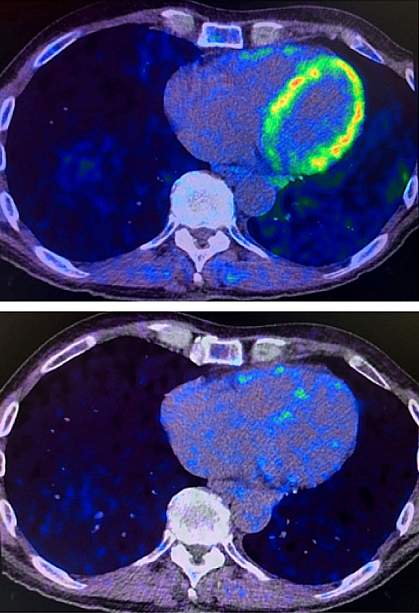You are here
November 21, 2023
PET scans of heart may aid early detection of Lewy body diseases
At a Glance
- NIH scientists found that PET scans of the heart may help to identify which at-risk people will later develop Parkinson’s disease or dementia with Lewy bodies.
- The findings may lead to improved approaches for early detection of these Lewy body diseases.

As the U.S. population grows older, there’s been a rise in age-related neurodegenerative diseases. Two such diseases are Parkinson’s disease and dementia with Lewy bodies. Because both involve abnormal structures, called Lewy bodies, inside nerve cells, they are referred to as Lewy body diseases. Lewy bodies contain a harmful form of a protein called alpha-synuclein. Symptoms of both diseases can include slow movement and cognitive impairment. Once symptoms arise, serious neurodegeneration has already occurred.
Researchers have been searching for ways to detect these Lewy body diseases earlier. Early diagnosis could help scientists study preventive approaches like lifestyle changes, dietary supplements, or medications.
Five years ago, an NIH research team led by Dr. David S. Goldstein reported results from a study that followed 27 people for at least three years. All participants had three or more risk factors for Parkinson’s disease. Risk factors included a family history of the disease, a reduced sense of smell, dream enactment behavior (a sleep disorder in which people act out their dreams), and orthostatic intolerance (problems upon standing, such as fainting or lightheadedness).
The researchers found evidence, using an imaging technique called 18F-dopamine PET scanning, that people who later were diagnosed with Parkinson’s disease already had severe depletion of the chemical messenger norepinephrine in their hearts. Norepinephrine is derived from dopamine, which is lacking in particular brain centers in people with Parkinson’s disease.
In a continuation of that study, the team has now assessed 34 at-risk people over a longer time period. Participants underwent 18F-dopamine PET scanning every 18 months for up to 7.5 years or until they were diagnosed with Parkinson’s disease. Results appeared in the Journal of Clinical Investigation on October 26, 2023.
The researchers confirmed that 18F-dopamine PET scans could distinguish the participants who would later be diagnosed with Parkinson’s or dementia with Lewy bodies. Those who had low levels of 18F-dopamine-derived radioactivity in the heart were highly likely to develop Parkinson’s or dementia with Lewy bodies. Of the nine people who had low radioactivity levels at their first scan, eight were later diagnosed with one of these Lewy body diseases. Of the 25 participants who initially had normal radioactivity levels, only one of the 11 who completed the seven years of follow-up developed one of the diseases.
These findings support the view that disorders like Parkinson’s and dementia with Lewy bodies feature early involvement of the autonomic nervous system, the system that regulates automatic body processes like heart rate and blood pressure.
“We think that in many cases of Parkinson’s and dementia with Lewy bodies, the disease processes don’t actually begin in the brain,” Goldstein explains. Rather, autonomic processes may malfunction in other body organs first, before the disease process reaches the brain. “The loss of norepinephrine in the heart predicts and precedes the loss of dopamine in the brain in Lewy body diseases,” he concludes.
Such indicators outside the brain may help researchers detect the earliest signs of Lewy body diseases before symptoms appear.
Related Links
- A Potential Blood Test for Parkinson’s Disease
- Night Breathing Patterns Identify People with Parkinson’s Disease
- Test Distinguishes Parkinson’s Disease from Related Condition
- Tracking the Spread of Parkinson’s Proteins from Gut to Brain
- Appendix Linked to Toxic Parkinson’s Protein
- Risk Factors for Heart Disease Linked to Dementia
- Progress in Parkinson’s: Deconstructing Dopamine Degeneration
- Parkinson’s Disease
- Lewy Body Dementia
References: Cardiac noradrenergic deficiency revealed by 18F-dopamine positron emission tomography identifies preclinical central Lewy body diseases. Goldstein DS, Holmes C, Sullivan P, Lopez G, Gelsomino J, Moore S, Isonaka R, Wu T, Sharabi Y. J Clin Invest. 2023 Oct 26:e172460. doi: 10.1172/JCI172460. Online ahead of print. PMID: 37883190.
Funding: NIH’s National Institute of Neurological Disorders and Stroke (NINDS) and National Human Genome Research Institute (NHGRI).
